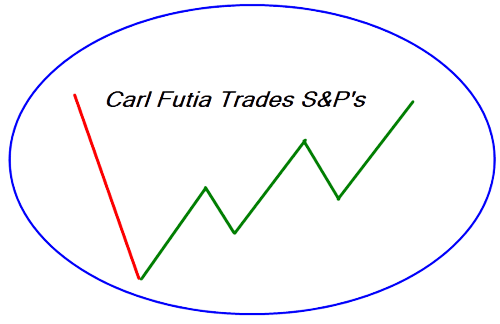I am a day trader. But I don’t believe in trends and can only identify market tops and bottoms with hindsight. Instead my approach is designed to exploit the volatility that amateur traders add the to market. I play only the long side because it is easer to detect amateur selling than amateur buying. The former tends to be more concentrated in time and price. Making only long side trades has the added advantage of simplifying my trading approach and reducing the number of decisions I make each day.
I keep a chart of all swings of nine or more points and, as a rule, I trade only when this chart is showing successively higher lows.
I buy in two possible situations. The first occurs when amateurs acting as a crowd show me concentrated selling – their orders keep hitting the bids with few or no intervening rallies. The second occurs when I think I see professional buying – I want to trade with these fellows, not against them. Having entered a long position for either reason I will then take profits on a rally which travels a statistically normal distance.
I don’t use indicators or oscillators of any kind. My charts record 30 minute all the way down to 10 second bars. So how do I know when amateurs selling is concentrated? This generally shows up as a bar with a range wider than average and a close in the lower part of the bar. Once I see this I then look for some sign that sellers are done before I buy – this usually is a brief period of sideways activity on my 10 second or 1 minute bar chart.
Not only do I fade amateur selling but I also want to join the professional crowd when they are buying. This often happens near previous low points on my bar charts or after a down swing has traveled about as far as some other recent down swing. Often these opportunities are associated with concentrated amateur selling but not always.
I make many trades when the market is volatile and fewer when it is not. My goal is to show a profit each day and to do this I must keep losses under control. Only about half my trades show a profit. Generally speaking I aim for profits of 10 or more ES points on a good trade and try to keep losses to 3 to 5 points on a bad one.
For the year 2022 I show a net profit of 3343 points per contract. Remember, this is all from long side trades made in a generally declining market! In 2023 my results were not as spectacular but still excellent – a net profit of 1227 points per contract. I report end-of-day trading results on my public Twitter account.
I think trading is a full time job and I spend my day watching the market closely. So if you have only limited time to devote to trading the odds will be stacked against you. But this is as it should be – there is no “free lunch” for traders.
